Evaluation of the Undrained Shear Strength in Preconsolidated Cohesive Soils Based on the Seismic Dilatometer Test
Abstract
1. Introduction
2. Methods and Materials
2.1. Dilatometer Test Procedure
2.2. Evaluation of Undrained Shear Strength From the Dilatometer Test
2.2.1. Single-Factor Relationships
2.2.2. Multi-Factor Relationships
2.3. Characteristics of the Tested Cohesive Soils
2.3.1. Ursynów Site
2.3.2. Bielany Site
2.3.3. Stegny Site
3. Results
3.1. Results of Seismic Dilatometer Tests
3.2. Results of Triaxial Tests
4. Evaluation of the Undrained Shear Strength Based on Empirical Relationships
5. Statistical Analysis
6. Conclusions
Author Contributions
Funding
Acknowledgments
Conflicts of Interest
References
- Mayne, P.W.; Coop, M.R.; Springman, S.M.; Huang, A.B.; Zornberg, J.G. Geomaterial behaviour and testing. State of the Art (SOA) paper. In Proceedings of the 17th International Conference on Soil Mechanics and Geotechnical Engineering, Alexandria, Egypt, 18–21 October 2009; Volume IV, pp. 2777–2872. [Google Scholar]
- Robertson, P.K. The James K. Mitchell Lecture: Interpretation of in-situ tests—Some insights. In Proceedings of the Fourth International Conference on Geotechnical and Geophysical Site Characterization, Porto de Galinhas, Brazil, 18–21 September 2012; Volume I, pp. 3–24. [Google Scholar]
- Marchetti, S. A new in situ test for the measurement of horizontal soil deformability. In Proceedings of the Conference on In Situ Measurement of Soil Properties, ASCE, Raleigh, NC, USA, 1–4 June 1975; Volume 2, pp. 255–259. [Google Scholar]
- Marchetti, S. In Situ Tests by Flat Dilatometer. J. Geotech. Geoenviron. Eng. 1980, 106, 299–321. [Google Scholar]
- Marchetti, S. Some 2015 Updates to the TC16 DMT Report 2001. In Proceedings of the 3rd International Conference on the Flat Dilatometer (DMT’15), Roma, Italy, 14–16 June 2015; pp. 43–65. [Google Scholar]
- Marchetti, S. Flat dilatometer (DMT). Applications and recent developments. In Proceedings of the Indian Geotechnical Conference, Pune, India, 16–19 December 2015. [Google Scholar]
- Marchetti, S.; Monaco, P.; Totani, G.; Calabrese, M. The flat dilatometer test (DMT) in soil investigations—A report by the ISSMGE Committee TC16. In Proceedings of the International Conference on Insitu Measurement of Soil Properties and Case Histories, Bali, Indonesia, 21–24 May 2001; p. 41. [Google Scholar]
- Marchetti, S.; Crapps, D.K. Flat Dilatometer Manual; Internal Report of GPE; GPE: Princeton, NJ, USA, 1981. [Google Scholar]
- Lutenegger, A.J. Current status of the Marchetti dilatometer test. In Proceedings of the 1st International Symposium on Penetration Testing (ISOPT-1), Orlando, FL, USA, 20–24 March 1988; Volume 1, pp. 137–155. [Google Scholar]
- Briaud, J.L.; Miran, J. The Flat Dilatometer Test; Publ. FHWA-SA-91-044; Civil Engineering Department, Texas A&M, for Federal Highway Administration: College Station, TX, USA, 1991.
- Ozer, A.T.; Bartlett, S.F.; Lawton, E.C. DMT testing for consolidation properties of the Lake Bonneville Clay. In Proceedings of the 2nd International Flat Dilatometer Conference, Washington, DC, USA, 2–5 April 2006; pp. 154–161. [Google Scholar]
- Schnaid, F. In Situ Testing in Geomechanics—The Main Tests; Taylor & Francis Group: London, UK, 2009; p. 327. [Google Scholar]
- Lechowicz, Z.; Rabarijoely, S.; Galas, P.; Kiziewicz, D. Settlement evaluation of spread foundations on heavily preconsolidated cohesive soils. Ann. Warsaw Univ. Life Sci. SGGW Land Reclam. 2011, 43, 111–118. [Google Scholar] [CrossRef]
- Robertson, P.K. Soil behavior type using the DMT. In Proceedings of the 3rd International Flat Dilatometer Conference, Roma, Italy, 14–16 June 2015; pp. 243–250. [Google Scholar]
- Cao, L.; Chang, M.F.; Teh, C.I. Analysis of dilatometer test in clay. In Proceedings of the 3rd International Conference on the Flat Dilatometer (DMT’15), Roma, Italy, 14–16 June 2015; pp. 385–392. [Google Scholar]
- Młynarek, Z.; Wierzbicki, J.; Lunne, T. On the influence of overconsolidation effect on the compressibility assessment of subsoil by means of CPTU and DMT. Ann. Warsaw Univ. Life Sci. SGGW Land Reclam. 2016, 48, 189–200. [Google Scholar] [CrossRef]
- Schnaid, F.; Odebrecht, E.; Sosnoski, J.; Robertson, P.K. Effects of the procedure on flat dilatometer test (DMT) results in intermediate soils. Can. Geotech. J. 2016, 53, 1270–1280. [Google Scholar] [CrossRef]
- Marchetti, S.; Monaco, P.; Totani, G.; Marchetti, D. In situ tests by Seismic Dilatometer (SDMT). In From Research to Practice in Geotechnical Engineering, Proceedings of the GeoCongress 2008, New Orleans, LA, USA, 9–12 March 2008; ASCE Library: Reston, VA, USA, 2008; pp. 292–311. [Google Scholar]
- Marchetti, S. The seismic dilatometer for in situ soil investigations. In Proceedings of the Indian Geotechnical Conference IGC-2014, Kakinada, India, 18–20 December 2014; pp. 1–9. [Google Scholar]
- Martin, G.K.; Mayne, P.W. Seismic Flat Dilatometer tests in Connecticut Valley varved clay. ASTM Geotech. Testing J. 1997, 20, 357–361. [Google Scholar] [CrossRef]
- Martin, G.K.; Mayne, P.W. Seismic Flat Dilatometer in Piedmont residual soils. In Proceedings of the 1st International Conference on Site Characterization, Atlanta, GA, USA, 19–22 April 1998; Robertson, P.K., Mayne, P.W., Eds.; 1998; Volume 2, pp. 837–843. [Google Scholar]
- Cavallaro, A.; Grasso, S.; Maugeri, M. Clay soil characterization by the New Seismic Dilatometer Marchetti Test (SDMT). In Proceedings of the Second International Flat Dilatometer Conference, Washington, DC, USA, 2–5 April 2006; pp. 261–268. [Google Scholar]
- Cavallaro, A.; Ferraro, A.; Grasso, S.; Maugeri, M. Site Response Analysis of the Monte Po Hill in the City of Catania. In Proceedings of the 2008 Seismic Engineering International Conference Commemorating the 1908 Messina and Reggio Calabria Earthquake MERCEA’08, Reggio Calabria and Messina, Italy, 8–11 July 2008; pp. 240–251. [Google Scholar]
- Carroll, R.; Long, M.; Ward, D. Use of CPTU and SDMT to characterise silty soil. In Proceedings of the Fourth International Conference on Geotechnical and Geophysical Site Characterization, Porto de Galinhas, Brazil, 18–21 September 2012; Volume I, pp. 214–249. [Google Scholar]
- Rivera-Cruz, I.; Howie, J.; Vargas-Herrera, L.A.; Coto-Loria, M.; Luna-Gonzales, O. A new approach for identification of soil behaviour type from seismic dilatometer (SDMT) data. In Proceedings of the Fourth International Conference on Geotechnical and Geophysical Site Characterization, Porto de Galinhas, Brazil, 18–21 September 2012; Volume II, pp. 947–954. [Google Scholar]
- Totani, G.; Monaco, P.; Marchetti, S.; Marchetti, D. Vs measurements by seismic dilatometer (SDMT) in non-penetrable soils. In Proceedings of the 17th International Conference on Soil Mechanics and Geotechnical Engineering, Alexandria, Egypt, 18–21 October 2009; Volume II, pp. 977–980. [Google Scholar]
- Monaco, P.; Marchetti, S.; Totani, G.; Marchetti, D. Interrelationship between small strain modulus Go and operative modulus. In Proceedings of the International Conference on Performance-Based Design in Earthquake Geotechnical Engineering (IS-Tokyo 2009), Tsukuba, Japan, 15–17 June 2009; Tsukamoto, K., Yoshimine, Eds.; 2009; pp. 1315–1323. [Google Scholar]
- Młynarek, Z.; Wierzbicki, J.; Stefaniak, K. Deformation characteristics of overconsolidated subsoil from CPTU and SDMT tests. In Proceedings of the Fourth International Conference on Geotechnical and Geophysical Site Characterization, Porto de Galinhas, Brazil, 18–21 September 2012; Volume II, pp. 1189–1193. [Google Scholar]
- Amoroso, S.; Monaco, P.; Marchetti, D. Use of the Seismic Dilatometer (SDMT) to estimate in situ G-γ decay curves in various soil types. In Proceedings of the Fourth International Conference on Geotechnical and Geophysical Site Characterization, Porto de Galinhas, Brazil, 18–21 September 2012; Volume I, pp. 489–497. [Google Scholar]
- Vargas, L.A.; Coto, M. Experiences in the use of DMT-SDMT in Costa Rica, Central America. In Proceedings of the Fourth International Conference on Geotechnical and Geophysical Site Characterization, Porto de Galinhas, Brazil, 18–21 September 2012; Volume I, pp. 375–382. [Google Scholar]
- Cavallaro, A.; Capilleri, P.; Grasso, S. Site Characterization by in Situ and Laboratory Tests for Liquefaction Potential Evaluation during Emilia Romagna Earthquake. Geosciences 2018, 8, 242. [Google Scholar] [CrossRef]
- Arroyo, M.; Di Mariano, A.; Monaco, P.; Devincenzi, M.; Perez, N. SDMT—based deep excavation design. In Proceedings of the Third International Conference on Geotechnical and Geophysical Site Characterization, Taipei, Taiwan, 1–4 April 2008; pp. 967–973. [Google Scholar]
- Młynarek, Z.; Gogolik, S.; Gryczmański, M.; Ulniarz, R. Settlement analysis of a cylindrical tank based on CPTU and SDMT results. In Proceedings of the Fourth International Conference on Geotechnical and Geophysical Site Characterization, Porto de Galinhas, Brazil, 18–21 September 2012; Volume II, pp. 1585–1590. [Google Scholar]
- Kulhawy, F.H.; Mayne, P.W. Manual on Estimating Soil Properties for Foundation Design; Report EK-6800; Electric Power Research Institute: Palo Alto, CA, USA, 1990. [Google Scholar]
- Burland, J.B. On the compressibility and shear strength of natural soils. Géotechnique 1990, 40, 329–378. [Google Scholar] [CrossRef]
- Houlsby, N.M.T.; Houlsby, G.T. Statistical fitting of undrained strength data. Géotechnique 2013, 63, 1253–1263. [Google Scholar] [CrossRef]
- Ching, J.; Phoon, K.-K. Multivariate distribution for undrained shear strengths under various test procedures. Can. Geotech. J. 2013, 50, 907–923. [Google Scholar] [CrossRef]
- Roque, R.; Janbu, N.; Senneset, K. Basic interpretation procedures of flat dilatometer tests. In Proceedings of the 1st International Symposium on Penetration Testing, Orlando, FL, USA, 20–24 March 1988; Volume 1, pp. 577–587. [Google Scholar]
- Smith, M.G.; Houlsby, G.T. Interpretation of the Marchetti Dilatometer in Clay. In Proceedings of the 11th European Conference on Soil Mechanics and Foundation Engineering, Kopenhaga, Denmark, 28 May–1 June 1995; Volume 1, pp. 1.247–1.253. [Google Scholar]
- Iwasaki, K.; Kamei, I. Evaluation of in situ strength and deformation characteristics of soils using a Flat Dilatometer. J. Geotech. Eng. 1994, 499, 167–176. [Google Scholar]
- Rabarijoely, S. The Use of Dilatometer Test for Evaluation of Organic Soil Parameters. Ph.D. Thesis, Warsaw Agricultural University—SGGW, Land Reclamation, Warszawa, Poland, 2000. (In Polish). [Google Scholar]
- Galas, P. Determination of Undrained Shear Strength Based on Seismic Dilatometer Test SDMT. Ph.D. Thesis, Warsaw University of Life Sciences—SGGW, Warsaw, Poland, 2013. (In Polish). [Google Scholar]
- Yu, H.S.; Carter, J.P.; Booker, J.R. Analysis of the dilatometer test in undrained clay. In Predictive Soil Mechanics, Proceedings of the Wroth Memorial Symposium, Oxford, UK, 27–29 July 1993; ICE Virtual Library: London, UK, 1993; pp. 783–795. [Google Scholar]
- Kamei, I.; Iwasaki, K. Evaluation of undrained shear strength of cohesive soils using a flat dilatometer. Soils Found. 1995, 35, 111–116. [Google Scholar] [CrossRef]
- Lutenegger, A.J. Cavity expansion model to estimate undrained shear strength in soft clay from dilatometer. In Proceedings of the Second International Flat Dilatometer Conference, Washington, DC, USA, 2–5 April 2006; pp. 319–326. [Google Scholar]
- Hong, S.J.; Shin, D.H.; Yoon, H.K.; Lee, C.; Lee, W.; Kim, Y.U. Strength and modulus of Busan clay by DMT. In Proceedings of the Third International Conference on Geotechnical and Geophysical Site Characterization, Taipei, Taiwan, 1–4 April 2008; pp. 377–382. [Google Scholar]
- Silvestri, V.; Tabib, C. Application of the MCC model for the estimation of undrained geotechnical parameters of clays from dilatometer tests. In Proceedings of the 3rd International Conference on the Flat Dilatometer (DMT’15), Roma, Italy, 14–16 June 2015; pp. 431–438. [Google Scholar]
- Lechowicz, Z.; Fukue, M.; Rabarijoely, S.; Sulewska, M.J. Evaluation of the undrained shear strength of organic soils from a dilatometer test using artificial neural networks. Appl. Sci. 2018, 8, 1395. [Google Scholar] [CrossRef]
- ISO 22476-11:2017 Geotechnical Investigation and Testing—Field Testing—Part 11: Flat Dilatometer Test; International Organization for Standardization: Geneva, Switzerland, 2017.
- ASTM D6635—15 Standard Test Method for Performing the Flat Plate Dilatometer; ASTM International: West Conshohocken, PA, USA, 2015.
- Lechowicz, Z.; Rabarijoely, S.; Kutia, T. Determination of undrained shear strength and constrained modulus from DMT for stiff overconsolidated clays. Ann. Warsaw Univ. Life Sci. SGGW Land Reclam. 2017, 49, 107–116. [Google Scholar] [CrossRef]
- EN ISO 14688-1:2002. Geotechnical Investigation and Testing—Identification and Classification of Soil—Part 1: Identification and Description; International Organization for Standardization: Geneva, Switzerland, 2002. [Google Scholar]
- EN ISO 14688-2:2004. Geotechnical Investigation and Testing—Identification and Classification of Soil—Part 2: Principles for a Classification; International Organization for Standardization: Geneva, Switzerland, 2004. [Google Scholar]
- STATISTICA—Package Documentation; StatSoft Polska Ltd.: Cracow, Poland, 2002. (In Polish)
- Stanisz, A. Accessible Statistics Course Using STATISTICA PL on the Examples of Medicine; StatSoft Polska Ltd.: Cracow, Poland, 2006; Volume 1. (In Polish) [Google Scholar]
- Stanisz, A. Accessible Statistics Course Using STATISTICA PL on the Examples of Medicine; StatSoft Polska Ltd.: Cracow, Poland, 2007; Volume 3. (In Polish) [Google Scholar]
- Draper, N.R.; Smith, H. Applied Regression Analysis, 3rd ed.; Wiley: New York, NY, USA, 1998. [Google Scholar]
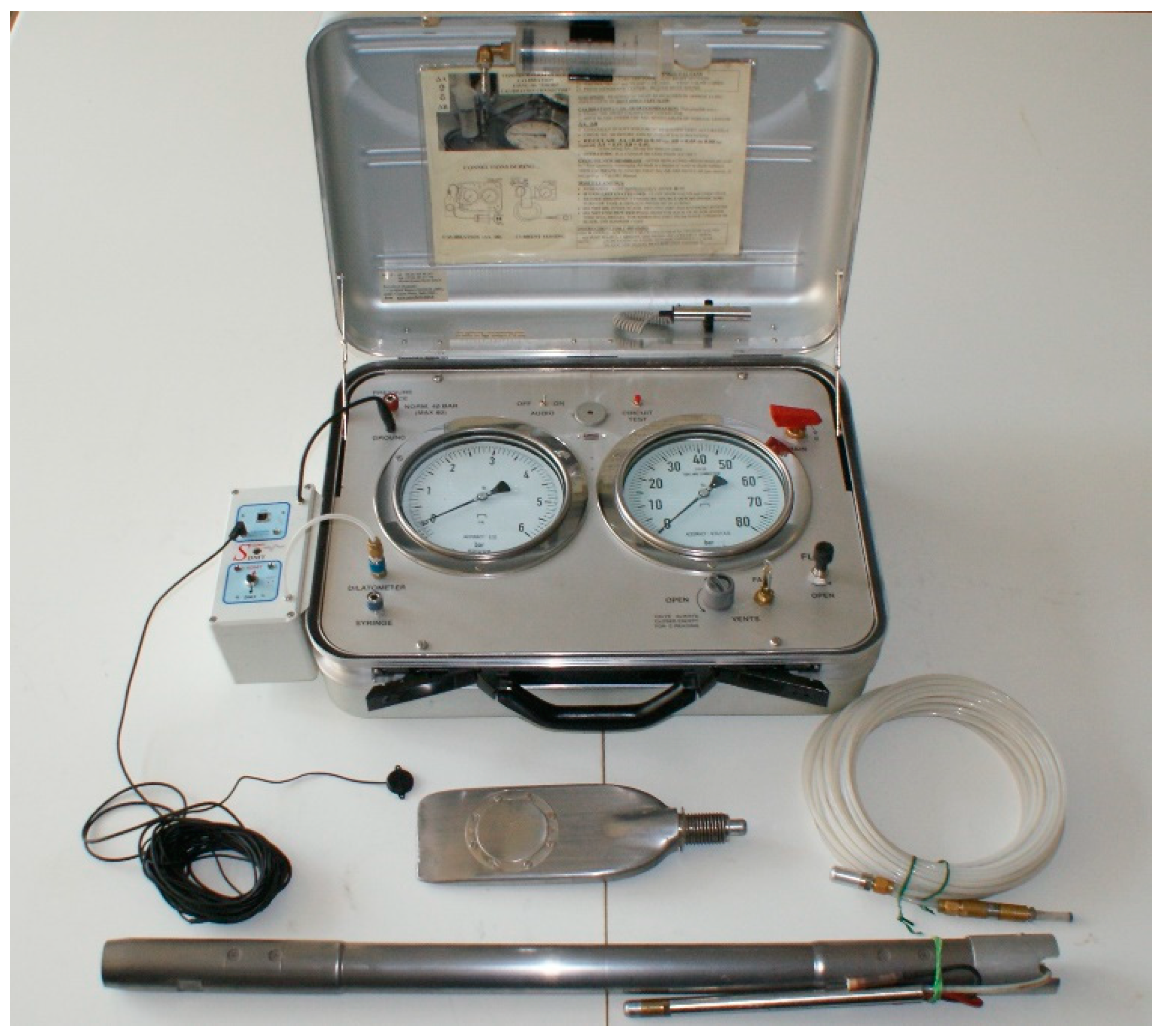


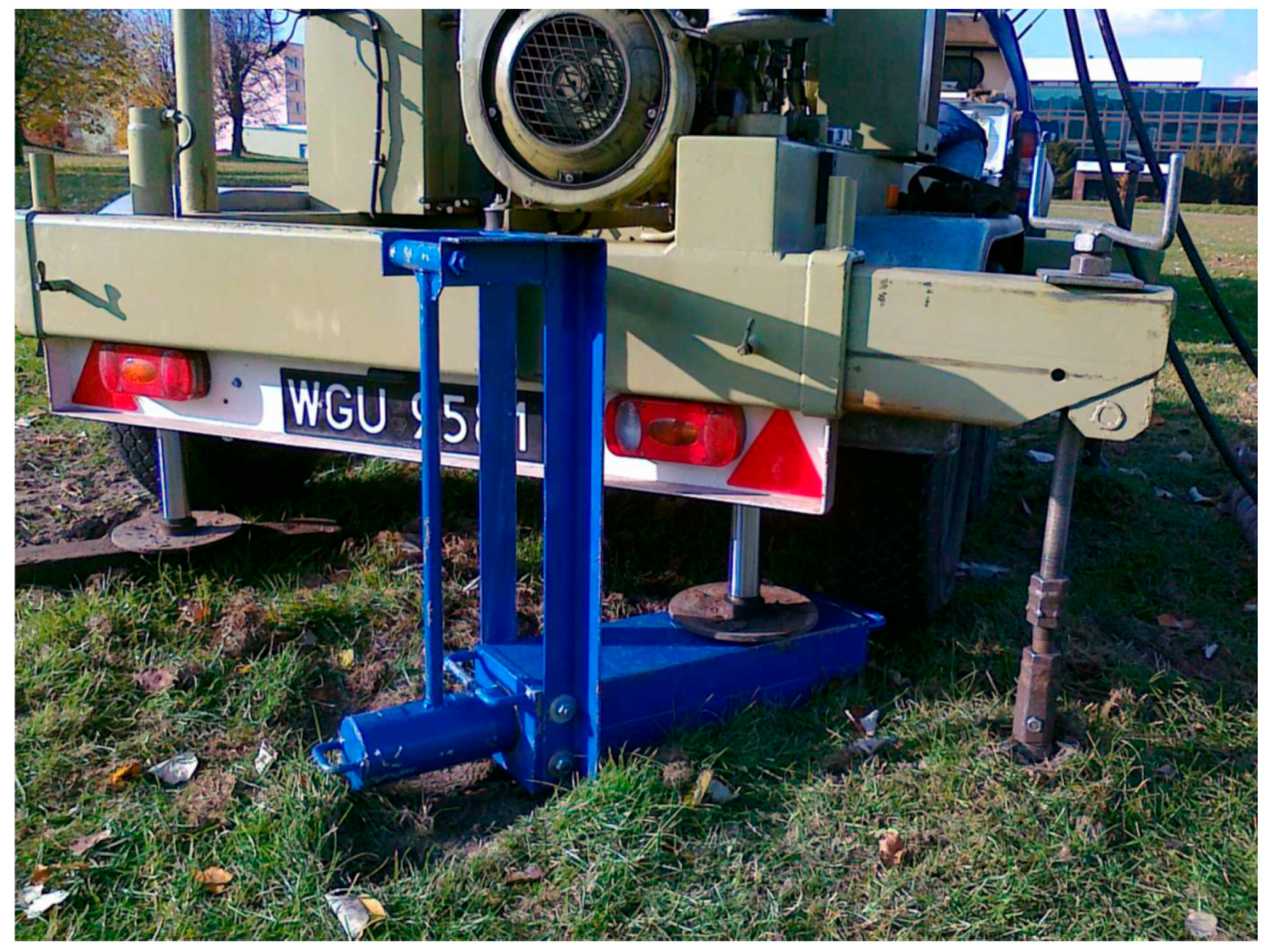
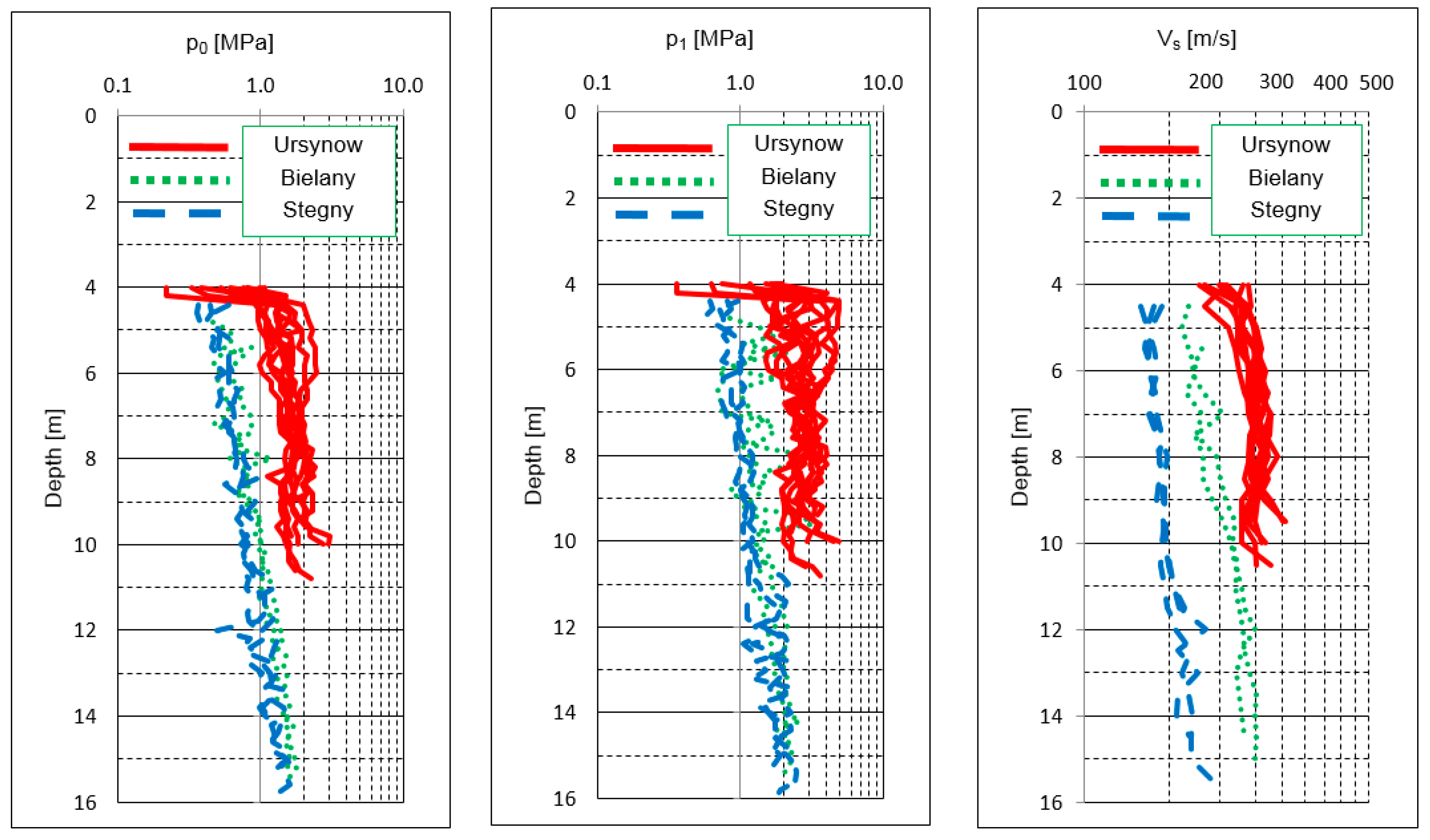
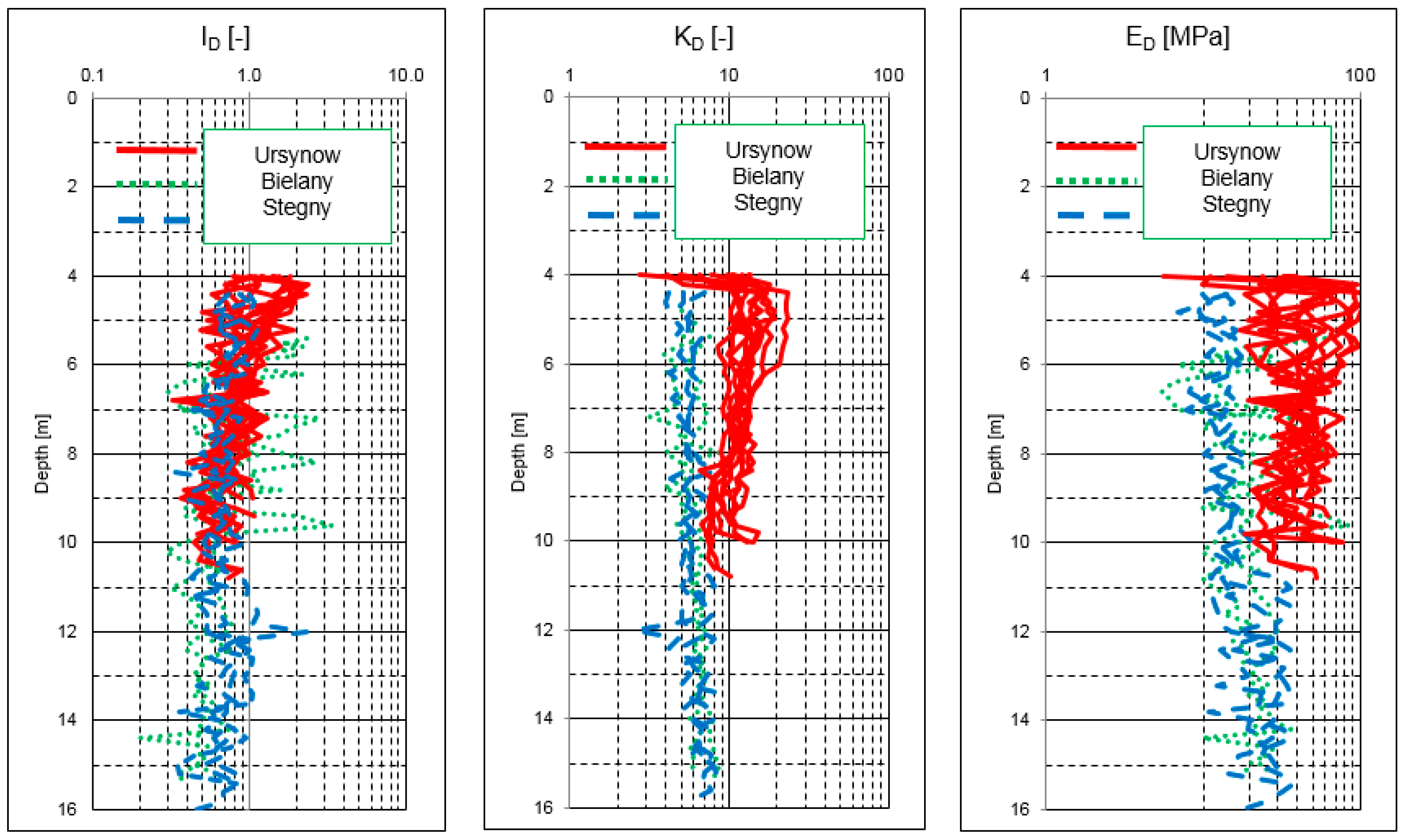

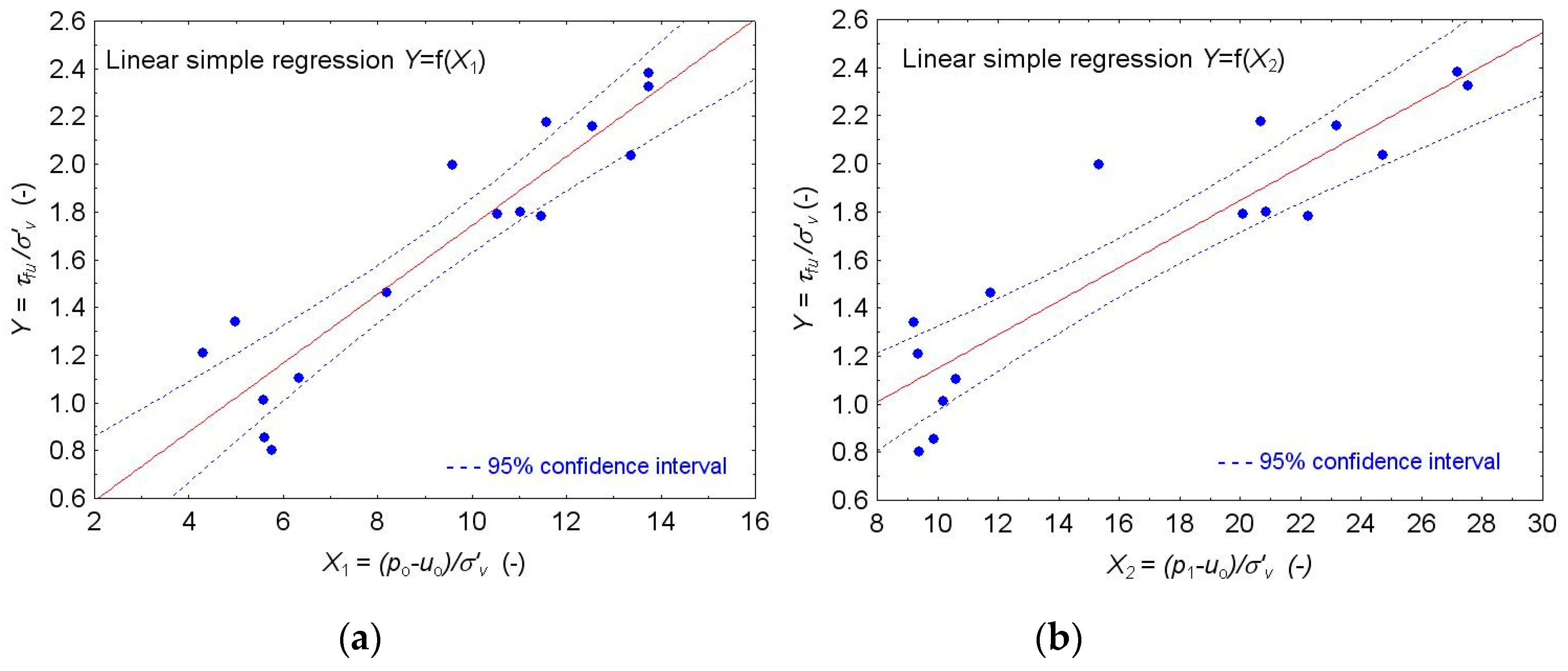
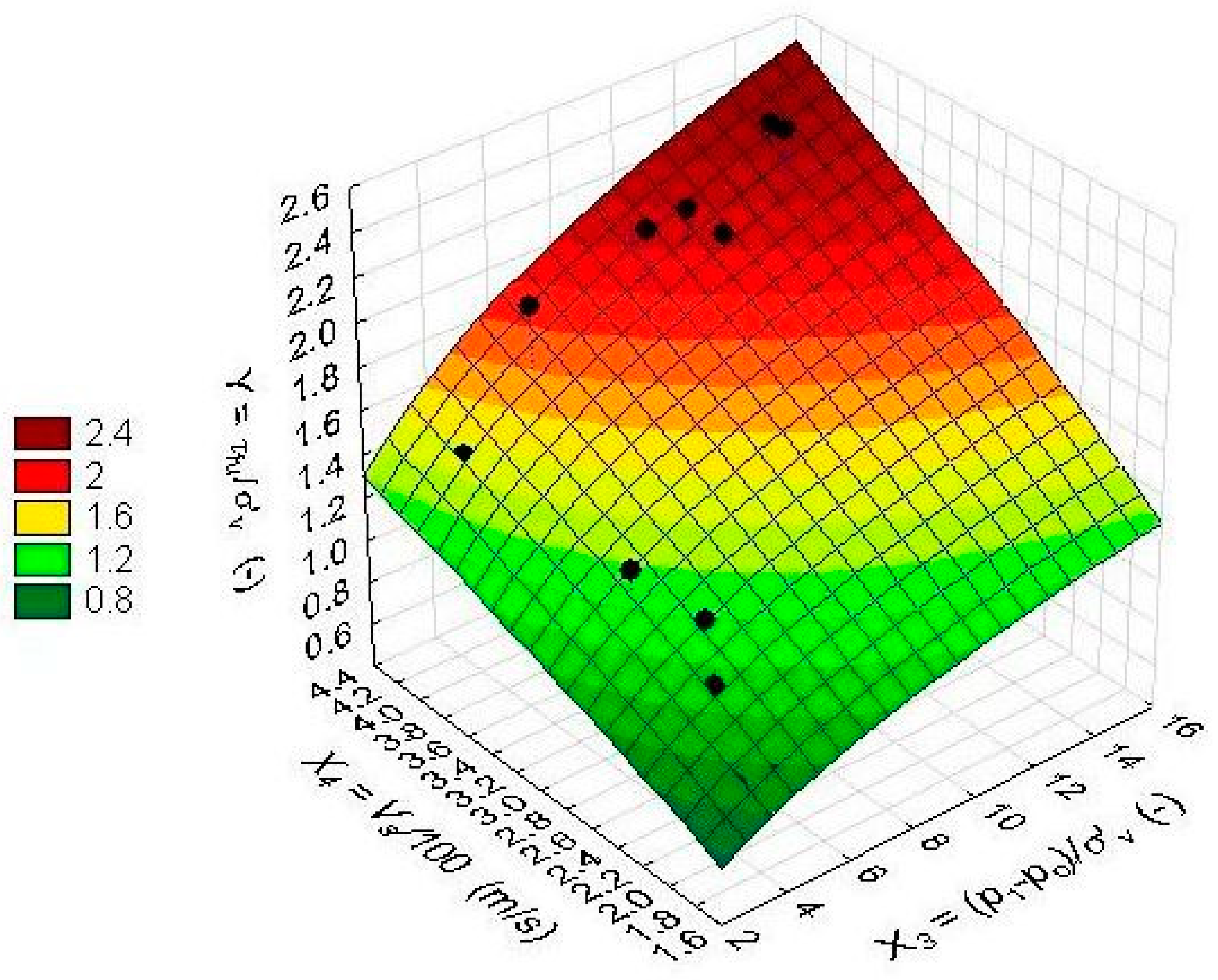
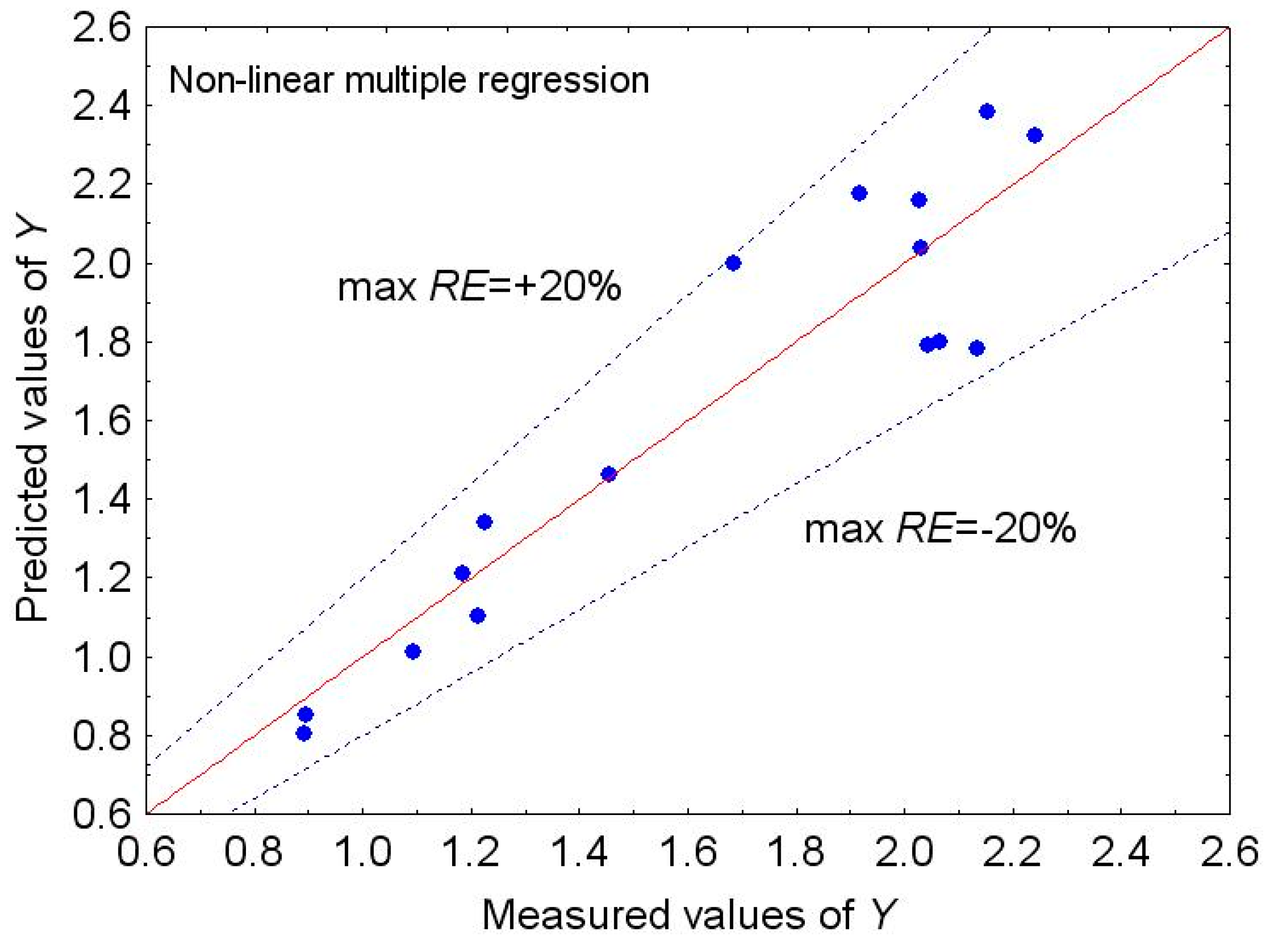
| Author | Equation | Independent Variable | Empirical Coefficients |
|---|---|---|---|
| Single-Factor Empirical Relationships | |||
| Marchetti [3] | (4) | KD | Marchetti [3] cohesive soils for ID < 1.2 S = 0.22, n = 0.5, m = 1.25 |
| Modified Marchetti | (5) | KD | Kamei and Iwasaki [44] marine clays S = 0.35, n = 0.47, m = 1.14 |
| Roque et al. [38] | (6) | (p1−σho) | Roque et al. [38] clays NC = 5−9 Galas [42] Pleistocene and Pliocene clays NC = 9.9 |
| Smith and Houlsby [39] | (7) | (po−σho) | Smith and Houlsby [39] clays ND = 4−7 Galas [42] Pleistocene and Pliocene clays ND = 4.9 |
| Multi-Factor Empirical Relationships | |||
| Rabarijoely [41] | (9) | σ’v (po−σho) (p1−σho) | Lechowicz et al. [51] Pleistocene and Pliocene clays αo = 0.18, α1 = 0.14, α2 = 0.20, α3 = 0.15 |
| Galas [42] | (10) | (po−σho)/σ’v (p1 − σho)/σ’v | Galas [42] Pleistocene and Pliocene clays ao = 0.164, a1 = 0.345, a2 = 0.544 |
| No. | Soil Type [53] | Depth | wn (%) | wL (%) | wP (%) | IP (%) | IC (-) | Fraction [52] (%) | Activity A (-) | |||
|---|---|---|---|---|---|---|---|---|---|---|---|---|
| (m) | Gr | Sa | Si | Cl | ||||||||
| Ursynów site–Auditorium | ||||||||||||
| 1 | clSa/sasiCl | 5.0–5.3 | 10.3 | 25.2 | 12.8 | 12.4 | 1.20 | 1 | 59 | 27 | 13 | 0.95 |
| 2 | clSa | 5.3–5.7 | 8.6 | 24.1 | 11.9 | 12.2 | 1.27 | 1 | 63 | 25 | 11 | 1.11 |
| 3 | clSa | 7.0–7.4 | 10.4 | 24.9 | 11.9 | 13.0 | 1.11 | 0 | 61 | 28 | 11 | 1.18 |
| Ursynów site–Building No. 37 | ||||||||||||
| 4 | clSa | 6.5–6.9 | 9.0 | 25.1 | 11.7 | 13.4 | 1.20 | 1 | 68 | 20 | 11 | 1.22 |
| 5 | sasiCl | 7.0–7.4 | 10.4 | 24.6 | 11.9 | 12.7 | 1.12 | 1 | 58 | 30 | 11 | 1.15 |
| 6 | sasiCl | 8.5–8.9 | 9.9 | 26.5 | 12.4 | 14.1 | 1.18 | 2 | 58 | 29 | 11 | 1.28 |
| Ursynów site–Building No. 34 | ||||||||||||
| 7 | clSa | 6.5–6.9 | 10.3 | 24.9 | 12.9 | 12.0 | 1.21 | 1 | 66 | 23 | 10 | 1.20 |
| 8 | clSa/sasiCl | 7.0–7.4 | 10.5 | 23.1 | 12.0 | 11.1 | 1.13 | 1 | 60 | 28 | 11 | 1.01 |
| 9 | sasiCl | 8.0–8.4 | 9.4 | 26.6 | 13.1 | 13.5 | 1.27 | 1 | 59 | 28 | 12 | 1.12 |
| Bielany site | ||||||||||||
| 10 | sasiCl | 15.0–15.4 | 10.4 | 30.9 | 13.1 | 17.8 | 1.15 | 1 | 52 | 31 | 16 | 1.11 |
| 11 | siCl | 7.1–7.6 | 19.2 | 38.0 | 18.8 | 19.2 | 0.98 | 0 | 7 | 73 | 20 | 0.96 |
| 12 | siCl | 8.5–8.9 | 21.1 | 34.6 | 17.5 | 17.1 | 0.79 | 0 | 7 | 73 | 20 | 0.86 |
| 13 | sasiCl | 12.0–12.5 | 11.4 | 27.7 | 12.3 | 15.4 | 1.05 | 1 | 57 | 29 | 14 | 1.10 |
| Stegny site | ||||||||||||
| 14 | Cl | 6.0–6.4 | 26.0 | 78.4 | 25.9 | 52.5 | 1.00 | 0 | 2 | 50 | 48 | 1.09 |
| 15 | Cl/siCl | 9.0–9.4 | 28.5 | 88.1 | 31.2 | 56.9 | 1.05 | 0 | 6 | 57 | 37 | 1.54 |
| 16 | Cl/siCl | 12.0–12.4 | 19.8 | 67.6 | 25.5 | 42.1 | 1.13 | 0 | 3 | 59 | 38 | 1.11 |
| Site | Values | po (MPa) | p1 (MPa) | Vs (m/s) | ID (-) | KD (-) | ED (MPa) |
|---|---|---|---|---|---|---|---|
| Ursynów | Mean value | 1.363 | 2.569 | 395 | 0.93 | 11.1 | 42 |
| Auditorium | Standard Deviation | 0.263 | 0.509 | 47.2 | 0.38 | 2.64 | 14.0 |
| Coefficient of Variation | 0.19 | 0.20 | 0.12 | 0.41 | 0.24 | 0.33 | |
| Ursynów | Mean value | 1.617 | 3.160 | 377 | 0.99 | 12.9 | 54 |
| Building | Standard Deviation | 0.420 | 0.924 | 40.5 | 0.46 | 4.04 | 23.7 |
| No. 37 | Coefficient of Variation | 0.26 | 0.29 | 0.11 | 0.46 | 0.31 | 0.44 |
| Ursynów | Mean value | 1.370 | 2.503 | 397 | 0.84 | 11.3 | 39 |
| Building | Standard Deviation | 0.397 | 0.716 | 41.9 | 0.21 | 1.41 | 13.2 |
| No. 34 | Coefficient of Variation | 0.29 | 0.29 | 0.10 | 0.24 | 0.12 | 0.33 |
| Bielany | Mean value | 0.972 | 1.610 | 320 | 0.78 | 6.1 | 22 |
| Standard Deviation | 0.343 | 0.509 | 57.0 | 0.62 | 1.04 | 12.8 | |
| Coefficient of Variation | 0.35 | 0.32 | 0.19 | 0.78 | 0.17 | 0.58 | |
| Stegny | Mean value | 0.810 | 1.337 | 196 | 0.71 | 5.9 | 18 |
| Standard Deviation | 0.286 | 0.473 | 23.9 | 0.19 | 0.96 | 7.2 | |
| Coefficient of Variation | 0.36 | 0.36 | 0.12 | 0.28 | 0.16 | 0.38 |
| Site | Soil Type | σ’v (MPa) | uo (MPa) | po (MPa) | (po − uo) (MPa) | (po − uo)/σ’v (-) X1 | p1 (MPa) | (p1 − uo) (MPa) | (p1 − uo)/σ’v (-) X2 | (p1 − po)/σ’v (-) X3 | Vs (m/s) | Vs/100 (-) X4 | τfu* (MPa) | τfu/σ’v * (-) Y |
|---|---|---|---|---|---|---|---|---|---|---|---|---|---|---|
| Ursynów | clSa/sasiCl | 0.094 | 0.0 | 1.286 | 1.286 | 13.739 | 2.544 | 2.544 | 27.179 | 13.440 | 388 | 3.880 | 0.223 | 2.382 |
| Auditorium | clSa | 0.102 | 0.0 | 1.399 | 1.399 | 13.743 | 2.802 | 2.802 | 27.525 | 13.782 | 407 | 4.070 | 0.237 | 2.323 |
| clSa | 0.135 | 0.0 | 1.545 | 1.545 | 11.461 | 2.999 | 2.999 | 22.248 | 10.786 | 424 | 4.240 | 0.240 | 1.780 | |
| Ursynów | clSa | 0.124 | 0.0 | 1.662 | 1.662 | 13.361 | 3.074 | 3.074 | 24.707 | 11.346 | 384 | 3.840 | 0.254 | 2.038 |
| Building | sasiCl | 0.137 | 0.0 | 1.583 | 1.583 | 11.580 | 2.829 | 2.829 | 20.695 | 9.115 | 390 | 3.900 | 0.298 | 2.176 |
| No. 37 | sasiCl | 0.170 | 0.0 | 1.631 | 1.631 | 9.594 | 2.604 | 2.604 | 15.318 | 5.724 | 398 | 3.980 | 0.340 | 1.997 |
| Ursynów | clSa | 0.120 | 0.0 | 1.322 | 1.322 | 11.017 | 2.501 | 2.501 | 20.842 | 9.825 | 421 | 4.210 | 0.216 | 1.800 |
| Building | clSa/sasiCl | 0.134 | 0.0 | 1.409 | 1.409 | 10.546 | 2.686 | 2.686 | 20.105 | 9.558 | 420 | 4.200 | 0.239 | 1.789 |
| No. 34 | sasiCl | 0.155 | 0.0 | 1.945 | 1.945 | 12.548 | 3.592 | 3.592 | 23.174 | 10.626 | 395 | 3.950 | 0.335 | 2.158 |
| Bielany | sasiCl | 0.185 | 0.097 | 1.610 | 1.513 | 8.1960 | 2.267 | 2.170 | 11.755 | 3.559 | 398 | 3.980 | 0.270 | 1.463 |
| siCl | 0.122 | 0.020 | 0.546 | 0.526 | 4.301 | 1.166 | 1.146 | 9.370 | 5.070 | 247 | 2.470 | 0.148 | 1.209 | |
| siCl | 0.143 | 0.034 | 0.746 | 0.712 | 4.989 | 1.350 | 1.316 | 9.222 | 4.233 | 283 | 2.830 | 0.192 | 1.342 | |
| sasiCl | 0.189 | 0.068 | 1.267 | 1.199 | 6.341 | 2.075 | 2.007 | 10.613 | 4.273 | 277 | 2.773 | 0.209 | 1.103 | |
| Stegny | Cl | 0.092 | 0.020 | 0.536 | 0.516 | 5.609 | 0.930 | 0.910 | 9.891 | 4.283 | 175 | 1.750 | 0.079 | 0.853 |
| Cl/siCl | 0.117 | 0.050 | 0.724 | 0.674 | 5.761 | 1.147 | 1.097 | 9.381 | 3.615 | 188 | 1.880 | 0.094 | 0.803 | |
| Cl/siCl | 0.142 | 0.080 | 0.873 | 0.793 | 5.585 | 1.528 | 1.448 | 10.197 | 4.613 | 229 | 2.290 | 0.144 | 1.011 |
| Single-Factor Relationships by: | Multi-Factor Relationship by: | |||||
|---|---|---|---|---|---|---|
| Marchetti [3] Equation (4) | Roque et al. [38] Equation (6) | Smith and Houlsby [39] Equation (7) | Rabarijoely [41,51] Equation (9) | Galas [42] Equation (10) | ||
| max RE (%) | max RE (%) | max RE (%) | max RE (%) | max RE (%) | ||
| Ursynów | A | 34.3 | 14.7 | 11.7 | 30.9 | 16.4 |
| 37 | 36.7 | 30.3 | 21.0 | 47.7 | 21.1 | |
| 34 | 22.8 | 6.0 | 2.8 | 42.5 | 8.6 | |
| Bielany | 43.9 | 47.6 | 43.2 | 35.9 | 33.9 | |
| Stegny | 21.3 | 7.4 | 24.5 | 40.5 | 28.7 | |
| Mean max RE | 31.8 | 21.2 | 20.6 | 39.5 | 21.7 | |
| Mean RE (from 16 tests) | ||||||
| 20.4 | 14.1 | 12.0 | 30.6 | 12.9 | ||
| Model | Equation Formula/No. | Determination Coefficient R2 (-) | SEE (MPa) | Max RE (%) | Mean RE (%) |
| Simple linear regressions | τfu/σ’v = 0.3023 + 0.1442((po − uo)/σ’v) (13)* | 0.855 | ±0.2089 | 41.0 | 12.4 |
| τfu/σ’v = 0.4513 + 0.0698((p1 − uo)/σ’v) (14)** | 0.831 | ±0.2262 | 37.7 | 13.0 | |
| τfu/σ’v = 0.6652 + 0.1258((p1 − po)/σ’v) (15)** | 0.751 | ±0.2747 | 39.4 | 15.0 | |
| τfu/σ’v = −0.1159 + 0.5178(Vs/100) (16)* | 0.757 | ±0.2714 | 33.0 | 12.0 |
| Model | Equation Formula/No. | Determination Coefficient R2 (-) | SEE (MPa) | Max RE (%) | Mean RE (%) |
|---|---|---|---|---|---|
| Linear multiple two-factor regression | τfu/σ’v = 0.0403 + 0.0728((p1 − po)/σ’v) + + 0.3055(Vs/100) (21)* | 0.881 | ±0.1972 | 19.1 | 8.5 |
| Non-linear multiple two-factor regression | τfu/σ’v = 0.3676 · ((p1 − po)/σ’v)0.2846 · · (Vs/100)0.7525 (22)** | 0.919 | ±0.0480 | 20.4 | 8.5 |
| Sites | Measured Values τfu/σ’v from CIU TT (-) | Predicted Values τfu/σ’v Using Equation (22) (-) | Relative Errors of Individual Case REp (%) | |
|---|---|---|---|---|
| Ursynów | A | 2.382 | 2.134 | 10.4 |
| 2.323 | 2.228 | 4.1 | ||
| 1.780 | 2.143 | 20.4 | ||
| 37 | 2.038 | 2.018 | 1.0 | |
| 2.176 | 1.918 | 11.9 | ||
| 1.997 | 1.706 | 14.6 | ||
| 34 | 1.800 | 2.076 | 15.3 | |
| 1.789 | 2.056 | 14.9 | ||
| 2.158 | 2.023 | 6.2 | ||
| Bielany | 1.463 | 1.490 | 1.9 | |
| 1.209 | 1.149 | 4.9 | ||
| 1.342 | 1.210 | 9.8 | ||
| 1.103 | 1.196 | 8.5 | ||
| Stegny | 0.853 | 0.847 | 0.8 | |
| 0.803 | 0.851 | 6.0 | ||
| 1.011 | 1.059 | 4.7 | ||
| Max REp = 20.4% | ||||
| The mean of the marked values | Mean Value of Max RE = 13.2% | |||
| Mean Value of RE = 8.5% | ||||
© 2019 by the authors. Licensee MDPI, Basel, Switzerland. This article is an open access article distributed under the terms and conditions of the Creative Commons Attribution (CC BY) license (http://creativecommons.org/licenses/by/4.0/).
Share and Cite
Galas, P.; Lechowicz, Z.; Sulewska, M.J. Evaluation of the Undrained Shear Strength in Preconsolidated Cohesive Soils Based on the Seismic Dilatometer Test. Appl. Sci. 2019, 9, 1660. https://doi.org/10.3390/app9081660
Galas P, Lechowicz Z, Sulewska MJ. Evaluation of the Undrained Shear Strength in Preconsolidated Cohesive Soils Based on the Seismic Dilatometer Test. Applied Sciences. 2019; 9(8):1660. https://doi.org/10.3390/app9081660
Chicago/Turabian StyleGalas, Paweł, Zbigniew Lechowicz, and Maria Jolanta Sulewska. 2019. "Evaluation of the Undrained Shear Strength in Preconsolidated Cohesive Soils Based on the Seismic Dilatometer Test" Applied Sciences 9, no. 8: 1660. https://doi.org/10.3390/app9081660
APA StyleGalas, P., Lechowicz, Z., & Sulewska, M. J. (2019). Evaluation of the Undrained Shear Strength in Preconsolidated Cohesive Soils Based on the Seismic Dilatometer Test. Applied Sciences, 9(8), 1660. https://doi.org/10.3390/app9081660





